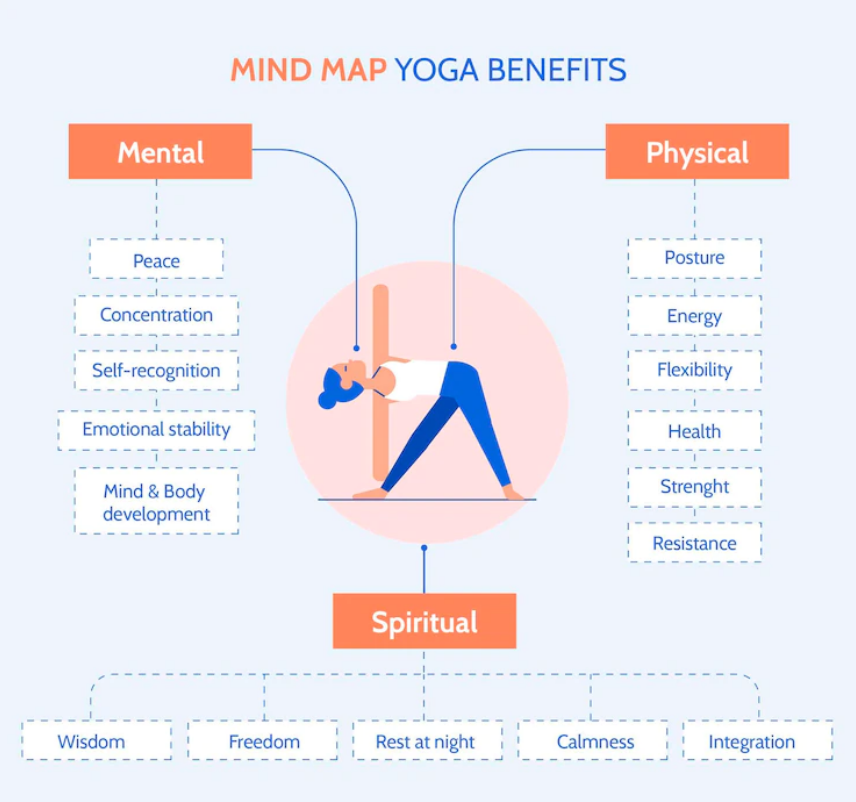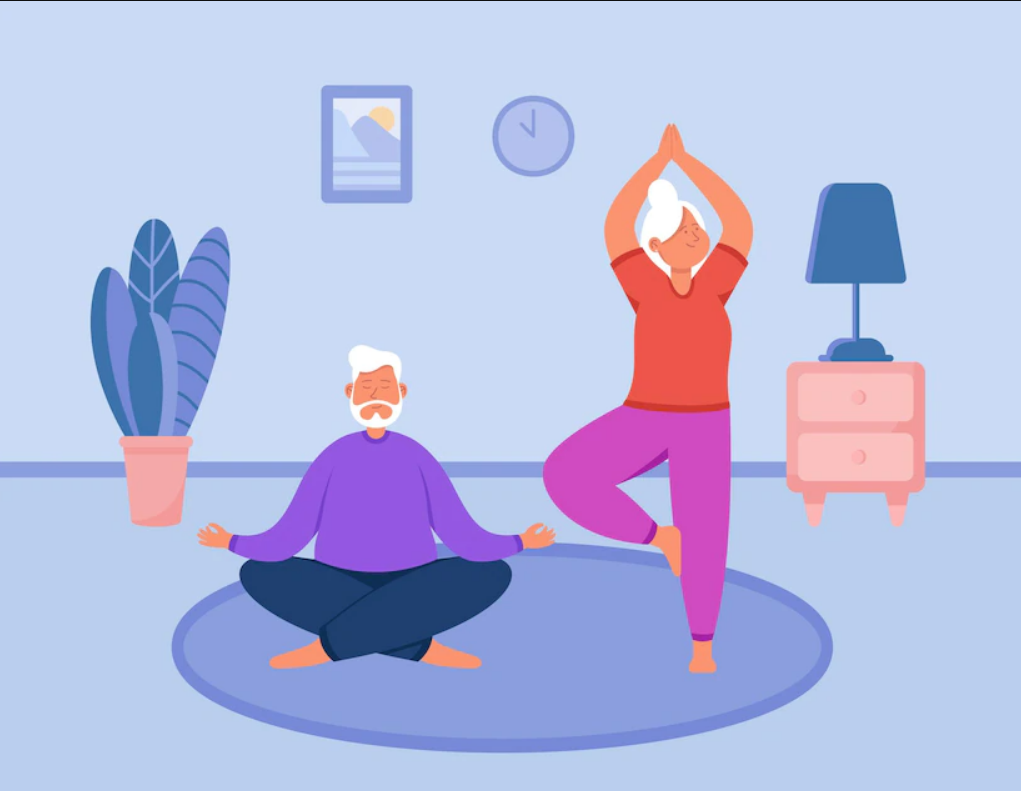It’s been stated that for many people, getting older is a privilege. But it can be difficult to graciously accept the various changes that come with growing older, particularly those that are hard to see but simple to feel, such as stiffness, pains, and instability. Each of us is impacted differently by the inevitable ageing process, but regular exercise, such as yoga, can alleviate its effects. In addition, it is irrelevant from where you start or what age you start.
Your body gets slower, less steady, less flexible, and less capable of endurance as time goes by. Muscle, tissue, and skin are the tissues that lose flexibility the fastest. As a result, you need to become used to viewing physical goals differently. Yoga can frequently lessen or relieve symptoms, even if you change your practice for common illnesses. Yoga can help you feel better whether you have back discomfort, a prosthetic knee, heart problems, poor lung capacity, weakened muscles, or low bone density.
The stretching, breathing, and meditation techniques of yoga can be a terrific approach for elders who are searching for a risk-free, efficient way to improve their physical health and general wellness. As you will see, daily yoga practice can actually have a variety of positive effects on older folks, from enhanced flexibility and balance to reduced stress and better sleep.
What are the benefits of yoga for the elderly?
Yoga develops a link between the mind and the body by combining stretching and strengthening poses with deep breathing and relaxation.
Yoga is safe for seniors of all fitness or ability levels since the poses, or asanas, may simply be modified or customized to meet an individual’s needs. In fact, it can be a fantastic way to maintain your body’s strength and health without putting unnecessary strain on your joints like weightlifting or jogging would. You may start yoga at any age, and it’s never too late to start.
(Just be sure to check with your doctor before you start.)
- Improved breathing: Yoga has little impact. This makes it a helpful movement technique if you have Asthma or other respiratory issues. A yoga practice also frequently includes pranayama, or breath work. If you have a persistent breathing issue, concentrating on inhaling and exhaling can be helpful since breathing exercises may assist to strengthen the muscles involved in breathing. Spending time practicing mindful breathing can also help you become more aware of your breath; by recognizing when you start to feel out of breath or short of breath, you can seek medical attention right away.
- Stronger bones: Try yoga if you’re concerned about osteoporosis and fragile bones. A regular yoga practice that incorporates weight-bearing postures can support bone strength in older women and men. Yoga practice may potentially help postmenopausal women’s bone density, according to some encouraging study.
- Better sleep: Yoga can benefit seniors who frequently experience sleep difficulties. Slow, deliberate breathing helps promote calm and relaxation. Before night, try a gentle yoga and stretching exercise to promote relaxation and sleep. Yoga can really make it easier for you to fall asleep and remain asleep longer, according to studies. Any form of exercise promotes tiredness and helps us get more exhausted, which can result in better sleep.
- Increased flexibility: For seniors, yoga poses are excellent stretching exercises. In order to enhance your range of motion, holding a position for a few breaths enables your muscles and connective tissues to relax and soften.
- For some more benefits of yoga, refer to the chart below

Different kinds of yoga
After reviewing some of the advantages of yoga, let’s discuss the kind of yoga poses that are best for elders.
- Vinyasa: This is a word used for several types of yoga that includes synchronizing breath with a succession of continuous motions that flow one after the other. Routines are frequently fluid and rapid, though pacing might vary. In vinyasa, the transitions between poses are just as important as the individual poses. It’s been compared to dancing by others. Although vinyasa yoga can be challenging due to its propensity for physical rigor, seniors who are in pretty good physical shape could relish the challenge.
- Kundalini: Kundalini yoga, also referred to as the “yoga of awareness,” might be appealing to elders who are particularly interested in both the spiritual and physical aspects of yoga. It incorporates moving into specific positions, breathing techniques, meditation, and chanting.
- Ashtanga: Ashtanga is a physically demanding, quick-paced form of yoga that consists of a set of poses that are always done in the same way. Some claim that ashtanga is the best style of yoga for losing weight because it is a tough, acrobatic exercise that increases circulation and heart rate. Even while it is typically not advised for beginners, some older folks find it to be quite helpful.
- Hatha: Hatha is a general phrase that refers to all styles of yoga that focus on physical postures and is not truly a specific style. The majority of hatha yoga courses, however, consist of a slow-moving succession of sitting and standing positions. Instead than raising your heart rate or putting your leg up behind your head, they usually focus on stretching and breathing. For this reason, a lot of people think hatha yoga is the greatest kind of yoga for beginners.
- Iyengar: Iyengar yoga is precise, exact, and heavily emphasizes good form. To aid in getting into the right alignment, practitioners are urged to use props such bolsters, straps, blocks, and incline boards. Seniors with arthritis or other chronic problems can benefit from this type of yoga since the props allow for a wide range of adaptations.
- Restorative: Using silent motion and no stretching, restorative yoga is a gentle, meditative style of yoga. Poses are held for a long duration, occasionally up to 10 minutes, and supports are employed to fully support the body. Elders who desire to develop calmness and contentment should practice restorative yoga. In class, dozing off is a typical occurrence.
How to prepare yourself for yoga?
- Analyze how fit you are.
While yoga can be practiced by everyone at any age, those with certain medical conditions should avoid particular movements. For instance, head-down or inverted stances should be avoided by those who have glaucoma as they can put more strain on the eyes. Therefore, it’s imperative to consult your doctor (and your instructor) before you try even a simple yoga routine.
- Prepare your gear.
Yoga requires flexible, comfortable attire. Since you will be bending into various postures and don’t want your shirt falling over your eyes, fitted clothing is ideal, especially for tops. Fitted T-shirts or tank tops go well with leggings or jogging bottoms. Yoga is normally practiced barefoot, so you won’t typically require specific footwear. However, if you’re worried about losing your balance, you can wear non-slip socks or even sneakers.
- Look for an experienced instructor.
It’s critical to choose a qualified instructor who is aware of the particular difficulties faced by the 55+ age group.
Ask prospective instructors about their experience teaching and whether they have any knowledge of working with older students or those who are ill. If you can, see a real class to get a feel for the instructor’s methods. Once you’ve decided on a teacher, be sure to let them know if you have any physical limitations, such as arthritis, back discomfort, balance issues, or high blood pressure etc.
Disadvantages of yoga
Like every physical activity, there is a risk of injury even in yoga, if you push yourself too hard or move anything incorrectly.
Although there aren’t many drawbacks to yoga, the following few may be considered:
- Threat of harm
- Finding the correct class or teacher is difficult
- Anxious about exercising in front of others
- Time Commitment
- Requires Patience
Conclusion

Despite a few minor drawbacks, senior yoga has many advantages for enhancing general health and well-being. Consult your doctor before beginning a yoga practice to make sure it’s a good fit for you. You’ll probably discover that the advantages exceed the drawbacks once you get going.
If you are a senior citizen looking for a way to stay active and improve your overall health, yoga is a great option. Yoga offers many benefits, from improved flexibility and balance to increased muscle strength and cognitive function. So why not give yoga a try? You may be surprised at how much it can improve your quality of life.
Remember as Alan Finger once said- “Yoga adds years to your life and life to your years.”




